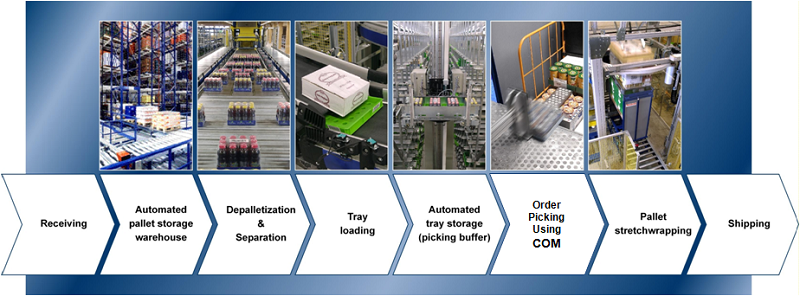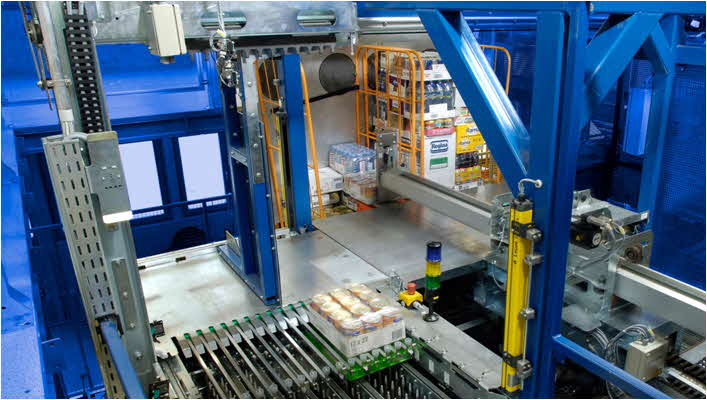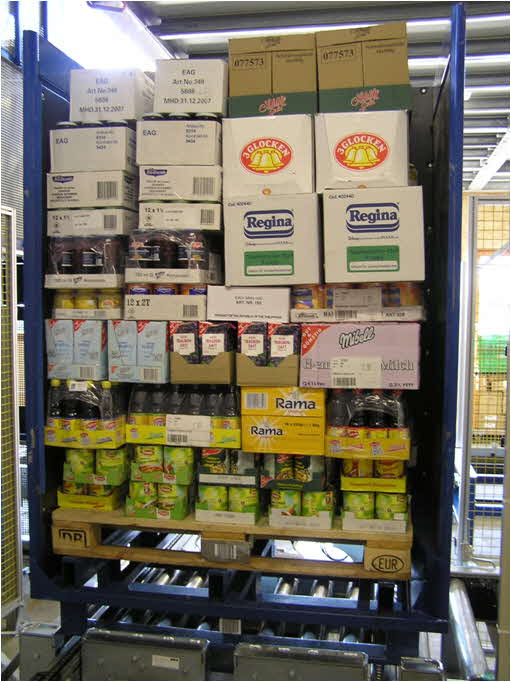|
Background Information
Currently, the vast majority of grocery distribution centers are operated as labor intensive, conventional operations. Previous attempts at automation have either been outright unsuccessful or have resulted in semi-automated facilities where ASRS equipment has replaced the use of forklifts. The age old challenge has always been the automation of the order selection function since this represents more than half of the direct labor hours in a typical grocery distribution operation. For years, companies have been trying to automate grocery order selection with only limited success to show for these efforts.
Several years ago, at the annual FMI (Food Marketing Institute) distribution conference, there was a presentation on the topic of “The Warehouse of the Future” where industry pundits illustrated their concepts on what a futuristic grocery distribution center would look like. Looking back, the concepts that were put forth at this conference were actually much less futuristic then anyone realized at the time.
Fast forward to the current day and the warehouse of the future is here. It took a full decade to design and a German company called Witron to engineer the solutions. The results are nothing short of breath taking. To see one of these operations in action is truly inspiring and a testimony to the ingenuity of the engineers who developed solutions to the many difficult challenges associated with grocery distribution.
This article takes a look at how a fully automated dry grocery distribution center actually works from receiving through to shipping.

Description of the Automated Grocery Distribution Center
To begin, some background information about the facility is provided for the purpose of illustrating the key concepts:
- 500,000 square feet; 65’ clear stacking height; roughly square in shape.
- Two-sided docks; receiving and shipping are on opposite sides of the complex with 30 receiving dock doors on one dock and 41 shipping doors on the other dock.
- Freestanding column supported facility structure (i.e. the building is not rack-supported).
- Combination of ESFR sprinklers and in-rack sprinkler systems.
- High bay storage consists of 2-deep static racks with 11 ASRS shuttle-table cranes which store and retrieve inbound pallets. There are no operating aisles within the high bay storage area - it is pure storage density.
- 32 mini-load cranes positioned on 2 levels (16 per level) which are used to store “ready reserve” inventory. This is the inventory that will be shipped over the next several days.
- 249,000 tray storage locations are provided within specialized racks. Two standard tray sizes are used (large and small) and each tray holds 1 case of product within the “ready reserve” section of the distribution center. Storage lanes are designed to hold 2 large trays or 4 small trays.
- 6 Univeyor depalletizing stations are used to automatically de-palletize layers of cases from pallets prior to transferring the cases to the case conveyor system.
- 32 sequence buffers are used to prepare outbound orders in the precise store-specific sequence prior to conveying the cases to the automated pallet building stations.
- 16 COM (Case Order Machines) are used to automatically construct outbound pallets in a nearly perfect store-specific store-aisle friendly sequence - without human intervention.
- 3 automated stretch wrapping machines that perform the final preparation of the outbound pallets and convey these finished stretch-wrapped pallets to the shipping dock.
- 6.6 Kilometers (4.1. Miles) of conveyor
- 640 Kilometers of cable
- 3800 Motors
- 13,000 sensors/monitors to support rapid problem response and maintain flawless inventory accuracy.
- 3 operating aisles for manual order selection supported by ASRS pallet putaway and letdown because about 100 - 150 SKUs are not suitable for automation due the nature of their packaging.
- A gas-fired 2.5 Megawatt generator is used to provide full power backup for the entire system.
Description of How the Automated Distribution Center Works
The following provides an overview of the operation:
- Inbound pallets are removed from trailers by receivers on counterbalance trucks at a rate of roughly 35 pallets per hour.
- Pallets are quickly inspected for quantity of cases, pallet quality or pallet overhang issues.
- Pallets are immediately transferred to 1 of 12 pallet conveyor induction lanes which is the last time that the merchandise will be handled by a human being until the time of loading on the shipping dock.
- All incoming palletized unit loads, regardless of the quality of the wood pallet that they arrive on, are automatically transferred onto a standard wooden 40” x 48” internal slave board. This ensures a consistent pallet quality to satisfy the stringent standards required by automation equipment. To accomplish this, vertical stacks of internal slave pallets are fed via pallet conveyor to be auto-inserted under each inbound pallet.
- The unit load is measured for weight, length, width and height against the system-expected item-specific attributes and any deviation greater than 6% is directed for further inspection by an operator to ensure that there has been no change to the packaging, pallet Hi x Ti configuration, etc.. The success of any automated entire system is predicated on having the highest quality of data to operate successfully, so all deviations must be identified and rectified at the time of receiving.
- If items have multiple variations in stock at the same time due to a limited time promotional program, packaging format change, etc. - then the system tracks each unit load with its unique attributes as an item variant which eliminates the need to have to set up a new item within the system.
- Upon acceptance into the system, pallets are elevated, two at a time, by a bank of 3 elevators, to a second-level mezzanine positioned above the receiving dock .
- Pallets are then conveyed through various check points that guide them to the appropriate transfer point and storage zone (e.g. deep reserve high bay storage, ready reserve, the manual selection area, etc.).
- Pallets being transferred to the high bay storage area are conveyed to one of 11 ASRS induction stations assigned by the WMS. Storage of merchandise by the ASRS is not entirely random. The WMS is designed to ensure that fast movers are positioned closest to the induction stations to minimize crane travel distance. Also, the WMS ensures that the stock movement workload is balanced evenly across the 11 cranes. Also, non-edible products such as chemicals are segmented away from edible food merchandise.
- The high bay storage area serves as the storage zone for merchandise that is referred to as reserve inventory. When the “pick” zone requires replenishment, the ASRS is instructed to pull pallets out of high bay storage. These pallets are then automatically conveyed to 1 of 6 de-palletizing machines. However, if the store orders a full pallet of merchandise then the pallet is directly conveyed to the shipping dock.
- Pallets that are conveyed to the de-palletizing stations are deposited onto a vertical elevator lift device. The pallet is elevated upwards to the Univeyor layer picking machine. The Univeyor Layer Picker® uses a patented low-vacuum chamber principle, with no suction cups, to lift layers of product off of pallets. A 4-sided cushioned clamping device is used to grasp product layers and once the layer is grasped, the pallet is lowered by the vertical lift and the layer is transferred (by sliding the layer sideways) onto a takeaway roller conveyor line.
- Note that the depalletization process potentially represents the weakest point in the system. If the case packaging is of poor quality then the bottom flaps of the carton may open and the inner product then falls to the ground creating an ugly mess. The Univeyor machine is pretty much capable of handling any type of flat-bottomed product - even when there are gaps in the layers. The machine is capable of picking more than 95% of products in retail distribution. Only about 100 grocery SKUs such as firewood, certain soda pop containers and bulkier product that is too difficult to depalletize actually needs to bypass the automation system which is remarkably few given that the facility stocks 7700 SKUs.
- The Univeyor machines are designed such that hundreds of small air suction channels lift the layer of cases of product off the pallet. A hooded 4-sided pillow cushioning device surrounds the layer to hold the cases tightly together during the lift off process. Whether it is one case on the layer, or several cases, or a full layer - the machine works remarkably flawlessly without causing damage to even the most fragile of SKUs.
- Once the layer has been removed, the pallet is conveyed back to the high bay storage zone if residual layers remain on the pallet, or if it is an empty pallet then the slave board and empty pallet are conveyed away to be deposited at designated locations. The slave boards are returned to the start of the loop where they are automatically stacked and returned to the induction stations at the receiving dock.
- Once the layer has been picked onto a powered takeaway conveyor line; cases are quickly arranged in single file by the conveyor. As required, cases are rotated 90 degrees depending on how they need to be stored on the trays. Cases are then quickly conveyed by a perpendicular powered takeaway conveyor to the tray induction point
- To enable automated order selection, every case is deposited to one of two standard tray sizes (small and large). To do this, cases are sent down an angled decline conveyor which deposits the cases onto empty trays that arrive under the case via an upward inclined conveyor. The whole process of depositing cases to trays is remarkably fast and flawless considering that each case needs to be rotated in the right direction to fit on its assigned tray type.
- Once the cases are deposited onto the trays, the system has a consistent material handling entity to work with which is what enables the automation of order selection. Trays are rapidly conveyed onwards to be stored into the “picking zone”. This zone is typically configured to hold between 2.5 and 3 days of supply for order picking purposes.
- The picking racks are designed to store roughly 249,000 trays (this can vary because small trays are stored 4-deep and large trays are stored 2-deep).
- Trays always hold 1 case per tray.
- Trays are conveyed to designated induction points where 32 high speed mini-load cranes (4 pods of 3 mini-loads on 2 separate levels) pull between 2 - 4 trays at a time from the conveyor staging / induction point.
- The mini-load then travels into the picking storage zone and deposits the trays to available pick locations. In effect, this is how pick slots are replenished except that the pick slots are semi-random within the system. There is slotting logic at work to ensure that the efficiency of the mini-load is maximized by slotting the fastest moving SKUs closest to the extraction point.
- Note that it is possible to commingle multiple SKUs within a pick slot but this tactic is only used when the system starts to fill up.
- When outbound orders are released to the WMS, the creation of pick commands are submitted to the 32 mini-load machines. The mirror-image of replenishment then takes place whereby the trays are extracted (2 - 4 at a time) from the picking racks where they are then transferred to a buffer area for proper sequencing.
- The software is designed to create outbound pallets that are stacked uniquely to the requirements of each individual store aisle sequence. The goal is to produce pallets that can be quickly and easily be replenished at the retail store based on how SKUs are sequenced within the store’s aisle layout.
- Most conventional warehouse operations produce outbound pallets that are sequenced to optimize the needs of the warehouse and trucking operations. As such, there is usually some type of labor penalty at the retail store to replenish the shelves since the cases are not stacked on the outbound pallets in a store-friendly fashion. People at the retail store have to travel around the entire store to replenish the store shelves which is why the industry has coined the phrase “around the world pallets”.
- Since cases on trays are pulled 2 - 4 at a time, they are placed into a small buffer section of conveyor (which is a series of conveyors and cross belts) where they can be shuffled around such that they are in the exact sequence needed for the subsequent palletization process.
- Trays are conveyed to staging lanes that precede each 16 COM (Case Order Machine). Each staging lane holds about 8 trays + 2 that can be buffered. The output of these machines is roughly 8,000 cases per hour.
- The COM is the machine that automatically constructs outbound pallets in store-friendly aisle sequence - with no human intervention.
- Cases re conveyed one at a time in single file to be placed in front of a pusher arm. This laser-guided mechanical arm slides the case forward across the surface of the pallet that is being stacked. The case is deposited to the exact XYZ coordinate on the pallet based on the software system which has pre-configured how every case is to be sequentially stacked onto the pallet.
- As each pallet layer is filled, the pallet is vertically repositioned downwards such that the topmost surface of the pallet is always flush with the surface of staging lane where the next outbound tray arrives. To do this, the outbound pallet inclines via a vertical lift table that continually adjusts the height of the pallet top-surface.
- Once each case is removed from the tray and “pushed” onto the surface of the outbound pallet, the empty tray is taken away via a decline conveyor which then transfers all empty trays back to the start of their journey at case induction.
- To ensure a perfectly built outbound pallet with no overhang, the pallets constructed by the COM have a 3-sided wall around the outer sides of the pallet so that the cases can be pushed up against the 3 walls which enhances pallet stability during the building process. This is one of the features that the retail stores truly appreciate the most.
 |
- The pallet drops vertically downward via elevator as the pushers build up each layer on the pallet up to an 8’ height.
- Once pallets are complete, they are transferred via pallet conveyor to one of three automated pallet stretch wrapping stations. At this point the pallet still has the 3-walled device surrounding it. At the shrink-wrap station, an elevator vertically elevates the outbound pallet until it is in the correct position to commence the shrink wrap process.
- A “plug is dropped onto the top of the pallet to apply downward pressure and then the arm rotates around the pallet applying the shrink-wrap while the 3-walled device is gradually lowered such that the pallet is ultimately wrapped and the device can be released.
- The empty 3-walled devices are then transferred away and elevated by elevator to be re-inducted into system.
- Finished pallets are then conveyed to 1 of 4 output lanes in reverse stop sequence and a team of 6-8 operators work the dock to top off pallets prior to RF loading pallets onto outbound trucks.

Food For Thought
- In a conventional full case grocery distribution center, let us say that a typical scratch rate is about 10 cases per 10,000 cases shipped. This rate can potentially increase to as much as 25 cases in an automated system if the equipment cannot keep up with the volume demands on peak shifts.
- The machines only have a certain number of output cycles and sometimes the system can fall behind on peak shifts resulting in the stores being shorted. Technically, once can design an automated system to handle worst case peak volumes but this is cost prohibitive so the facility will be designed to handle normal volumes out to a design year time horizon. Peaks can always be handled by moving some high volume SKUs out of the system into a conventional or semi-conventional aisle(s) on the busiest days of the year.
- Having said this; the overall DC fill rate will run at about 99.95% which is certainly a respectable number.
- In a conventional operation, late incoming receipts can be immediately allocated and shipped if the product is in high demand but with automation it takes approximately two hours to move an inbound case through the entire system so there can be less responsiveness as compared to a manual operation.
- Similarly, stores will not be able to submit late hand bills (order add-ons) at the last minute and expect to have them filled for the same reason.
- On a positive note, this concept enables each incremental case output to cost about 25% of what the same case would ship for in a conventional environment. This implies that companies that need distribution centers to be designed for good volume growth make the best candidates for automation (as compared to companies that are defensively trying to maintain market share).
- Lastly, the ability to add new SKUs to this type of an automated distribution center is easy to accomplish and can be designed into the system. In a conventional environment where ground-level real estate is always under pressure, it is not unusual to have to get rid of an item anytime a new item is introduced.
Companies that are investing in these highly automated facilities are not necessarily driven by a short term return on investment motive. These facilities are expensive to design and construct and they are more complex to operate than a conventional operation. Automation and flexibility are at opposite ends of the pendulum and a great deal of planning and technology needs to go into one of these operations.
There is a longer term vision taking place here which has more to do with labor strategy. Companies with vision are clearly recognizing that changing population demographics will make it more difficult to attract and retain people who are willing to perform the physically demanding 7 x 24 work that is common place in a grocery distribution center. As labor availability drops, the cost of labor will rise proportionately whereas the depreciation of building and equipment will remain reasonably inflation-free. Once the depreciation expense is paid off the ongoing maintenance expense bill is a small fraction of the labor expense of a conventional operation.
Organized labor is widespread throughout the grocery industry and automated distribution centers clearly require significantly less unionized labor than conventional facilities. Its is a hard cold fact that the competitive landscape has been permanently changed since 1988 when nonunion WalMart began testing the sale of groceries for the first time at a new supercenter in Washington, MO. The reality of the current market place is that radically different distribution solutions are need to provide the sustainable competitive advantage needed to survive in the grocery industry of tomorrow.
It will be very interesting indeed to see how many companies jump on the automation bandwagon now that these solutions have been proven to work successfully in multiple facilities for both Dry grocery and frozen operations. For more information, a video of this type of operation can be seen if you click here.
Marc Wulfraat is the President of MWPVL International Inc. He can be reached at +(1) (514) 482-3572 Extension 100 or by clicking here. MWPVL International provides automation consulting services to grocery distribution companies. Our services include: distribution network strategy; distribution center design; material handling and automation design; supply chain technology consulting; product sourcing; 3PL Outsourcing; and purchasing; transportation consulting; and operational assessments.

|